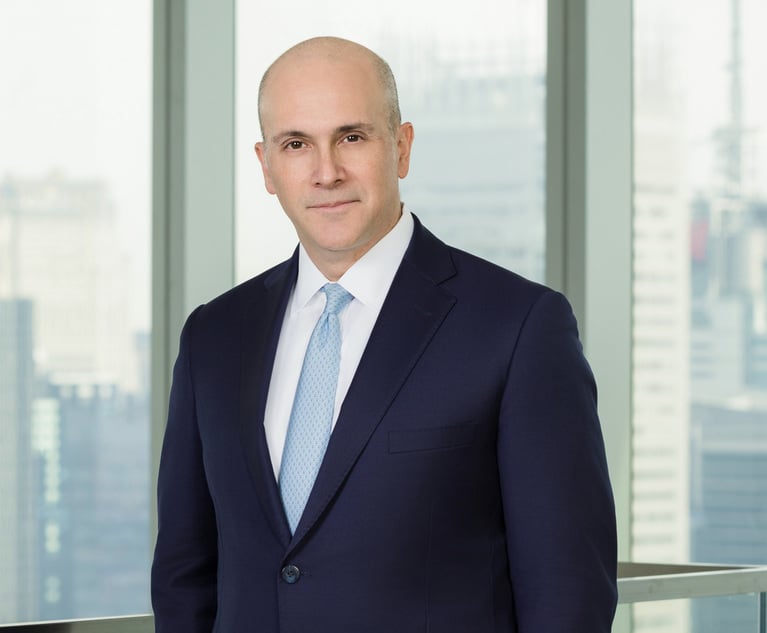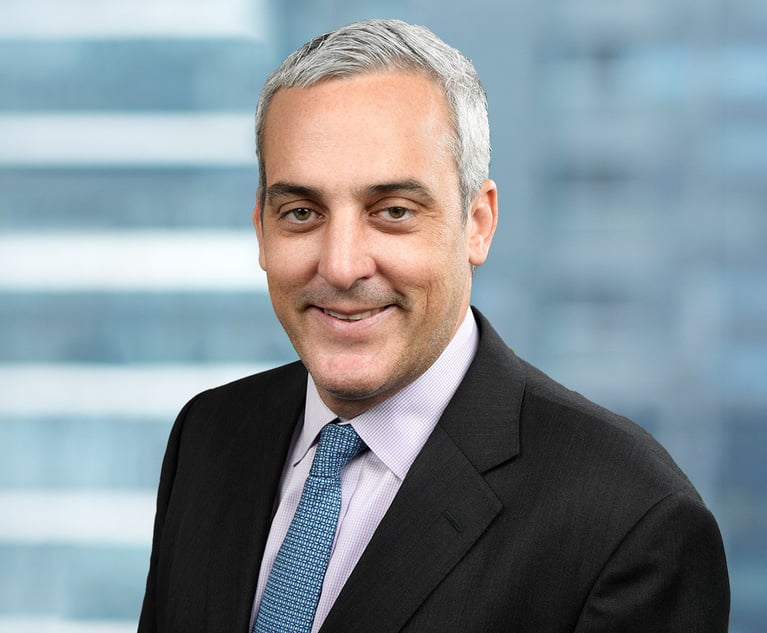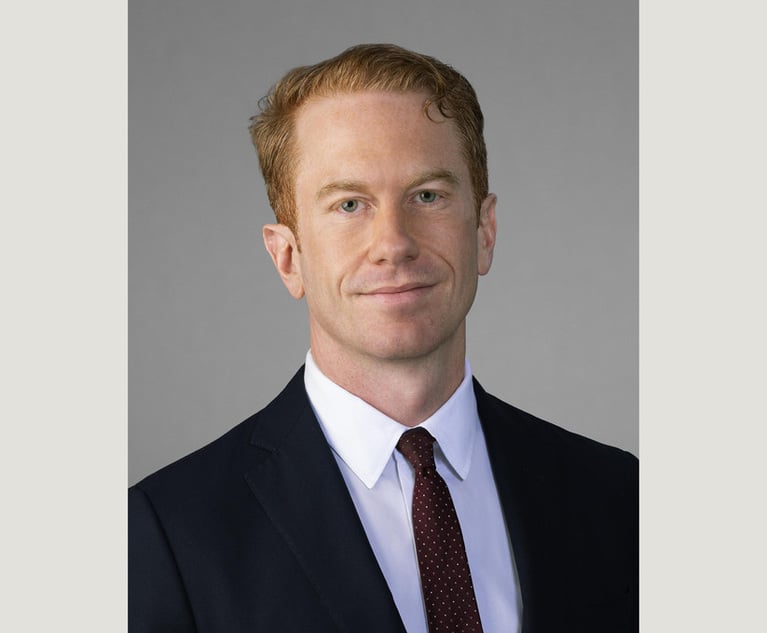For the Am Law 100, Mergers Don't Always Mean Immediate Results
An analysis of recent history shows that it often takes time before a merger delivers top-line growth, especially in times of crisis.
April 21, 2020 at 09:35 AM
13 minute read
 Credit: Kevin Fales
Credit: Kevin Fales
Law firm merger activity had ground to halt by the end of the first quarter in 2020, as firm leaders scrambled to handle the pressing logistical and safety concerns created by the coronavirus pandemic. But the legal industry is expected to see deals in the months and years ahead due to more volatility in the market, as well as the situations of several firms that were in turmoil even before the crisis began, legal market observers say.
Industry watchers expect groups of partners to leave less-resilient firms and those with uncertain futures. They also anticipate acquisitions by law firms seeking teams of high-performing lawyers who wouldn't have considered moves before the crisis. "There will be some opportunities that come up when things are not stable," as consultant Lisa Smith at Fairfax Associates put it.
While these types of distressed deals often involve tighter timelines and more due diligence to determine who will make the cut, firms will use many of the same factors as they would have before the pandemic in seeking to gauge the success of a deal, Smith and other consultants say. Those factors include an increase in a firm's share of large client relationships; additional revenue that it could not have generated without a merger; a deeper level of expertise in core practices; complementary strength in related practices; improved standing in league tables and rankings; and attracting and retaining top talent.
Using ALM Intelligence data, an analysis of four Am Law 100 mergers in the last decade, some of which took place in the wake of the Great Recession or involved firms struggling with partner defections, reveals that firms didn't gain significant additional revenue immediately post-merger. In many ways, some are still a work in progress. But leaders of these firms say they did see immediate success in other areas, ultimately leading to higher revenue per lawyer and more efficient firms.
The Immediate Results
It's been five years since the combination of Locke Lord and Edwards Wildman Palmer, the latter of which saw sliding revenue, layoffs and mounting partner exits before the merger. But the combined firm revenue continues to be about $200 million below what the firms made in total as two separate entities. For instance, in 2014, the year before the firms combined, their revenue together was $718.5 million. Last year, the firm grossed $496.43 million.
Arnold & Porter and Kaye Scholer's merger became effective in 2017, after the latter experienced revenue declines for six straight years and a shrinking equity partnership amid defections. But the combined firm's top line has also slightly lagged behind the total of its predecessor firms' historic revenues, which together totaled more than $1 billion two years before the merger. For the past two years, the firm's revenue has been mostly flat. It was $951.9 million in 2019.
The combined Arnold & Porter's revenue growth has been impaired by the lax regulatory environment under the Trump administration, chairman Richard Alexander says, a weight that could be lifted next year if Trump loses his reelection bid in November.
"We do have a substantial regulatory practice, an important market differentiator," Alexander says. "There is no question that the current administration's focus on deregulation has had an impact on those practices."
Hogan Lovells, meanwhile, was formed in the years following the Great Recession, in 2010, when London-based Lovells and Washington, D.C., firm Hogan & Hartson joined forces. The combined firm saw flat revenue growth at best in its first two years, hovering around $1.6 billion, a modest step back from the legacy firms' total combined revenue in the years leading up to the merger. Only in its fourth year did Hogan Lovells begin to grow its top line, and the firm's growth continued, even with declines in the value of the pound.
Unlike many other combinations, the 2012 merger of Indianapolis-based Baker & Daniels and Minneapolis-based Faegre & Benson immediately produced revenue growth. Faegre Baker Daniels has seen moderate improvements to its top line nearly every year since its combination, ranging from 1% to 5%. The success of that merger, its firm leaders say, led them to consider a combination with Drinker Biddle & Reath, a move that led to this year's creation of the new firm, Faegre Drinker Biddle & Reath.
Infographic design by Roberto Jiménez/ALM
Digging Deeper
Conversations with each of these firm's leaders show they don't rely on revenue growth alone to measure the success of their mergers.
David Taylor, chair of Locke Lord, notes that revenue decreased by roughly $100 million from the beginning of the combination in 2015 to last year, as head count fell by about 240 lawyers. He says the head count drop was expected and naturally happened—a result of attrition, "ongoing practice management based on overcapacity," retirement, some unwanted departures and some attorneys going in-house or to smaller firms.
"If you have a decline in head count, that will potentially lower your revenues," Taylor says. "We expected to see revenue decline, because as law firms you always have to look at overcapacity. As you look at that and you realize, we don't have enough work, we're at overcapacity levels, and we need to take certain actions."
But revenue per lawyer has been rising each year since the combination, increasing from $705,000 in 2015 to $812,000 last year. In fact, Locke Lord's revenue per lawyer growth has, in most years, beaten the average year-over-year growth of the Am Law 200 in the same metric, according to ALM Intelligence data.
Taylor says the firm has looked to revenue per lawyer, among other factors, to measure the success of the merger. "The key that we watch is the revenue per lawyer going up, which means the people exiting were lower revenue lawyers," he says.
Hogan Lovells and Faegre Baker Daniels also delivered year-over-year revenue per lawyer growth that was even with or outpaced the Am Law 200 average for most years after their combinations.
In its first year of the merger, Arnold & Porter's RPL shot up 8% from the average of the legacy firm's RPL—an increase way above the Am Law 200 industry average—and has since seen moderate growth. Alexander says the firm has "done a good job these three years of setting the building blocks" and while he wasn't going to give grades, "we've done the hard blocking and tackling necessary to put us in a good position" to grow practices.
Alexander also considers other metrics when gauging the firm's post-merger success, including its ability to expand its product offerings to clients, he says.
"That's really been a home run. We didn't do it to get bigger, to spread expenses over a larger attorney base," he says of the merger. "This was very much client-driven."
The Client's View
The four merged firms all saw positive year-over-year profits per partner growth after their combinations, but in some years they still lagged behind average industrywide growth.
In general, there's no rule of thumb about how much revenue, revenue per lawyer or profits per partner should increase after a merger, according to Kent Zimmermann, a law firm management consultant at the Zeughauser Group. Firms often see a dip in some of their numbers in the first three years after a merger, he says, and that dip could represent an investment that will work out over time.
Eventually, though, a firm's post-merger revenue should exceed the sum of its predecessors' revenue, Zimmermann says. But more important is whether the merging firms' financial goals are achieved faster together than they would have been if the firms remained separate. Several law firm leaders consider "but for" revenue gain after a merger, he says—revenue that combined firms wouldn't have captured if not for their merger—as well as growth in large client relationships.
Indeed, several firm leaders say their number of such relationships grew to become more than the legacy firms' total.
At the beginning of the Hogan Lovells merger, the combined firm had about 10 client relationships worth over $20 million in business, firm CEO Steve Immelt says. Today it has at least 20 such relationships, he notes, and many of those aren't the same clients as they were a decade ago.
Locke Lord has more large-fee clients today—those above $5 million—than it did in the first year of its combination, in 2015, Taylor says. He adds that the firm's "but for" revenue was "easily in the tens of millions over five years." For instance, after the merger, the firm had newfound opportunities to match Locke Lord's energy clients with Edwards Wildman's private equity expertise, Taylor says.
But even five years after Locke Lord and Edwards Wildman's merger, a period during which the firm has done a good job of realizing the benefits of a combination, Taylor says, "I wouldn't say we're done with it." As he notes, there's always a need to educate partners about opportunities across the firm.
At Arnold & Porter, Alexander says the combined firm has increased its share of anchor clients, though he declines to discuss specifics. By way of example, he says Kaye Scholer's legacy client base—pharmaceutical and other life sciences companies—are now being advised on pricing, Food and Drug Administration counseling, government investigations and antitrust work—core practice areas from the Arnold & Porter side.
"If you have a client that either firm had two touchpoints," Alexander says, "in the combined firm, we're now doing a dozen, or 15 or 20."
Alexander also acknowledges that there's still more to be done to maximize the benefits of the firm's merger. Three years later, Arnold & Porter's leadership wants to make sure there's "depth of practice" throughout all offices and wants to build its transactional group.
"We have been spending a lot of time focusing on the growth of our offices outside New York and Washington, and we've been actively involved in lateral discussions," he says.
In each quarter for several years after the Faegre Baker Daniels combination in 2012, the firm's leaders measured "cross-legacy time"—matters that originated with one legacy firm and were then billed by lawyers from the other side.
"We saw a steady increase, every quarter," says Andrew Humphrey, a chairman emeritus of Faegre Drinker, adding that the firm plans to track the same metric with the Drinker combination.
Firm leaders say their clients notice the improved offerings, leading to a jump in certain rankings.
The driving considerations for Hogan Lovells' merger, Immelt says, included the ability to offer clients a top-performing global firm. Hogan had a small international presence, including an office in London. "But they weren't at scale," Immelt says, adding that the merger "immediately brought us to scale, so we were in the same quality and size that we were in the U.S." The merger also gave the firm the ability to advise on significant cross-border transactions, disputes and policy work, he says.
The firm's practice area rankings reflect the change. If Hogan & Hartson had a Chambers ranking in London, Immelt says, it was Band 5. "Suddenly, we were filled with lawyers in Band 1," he says.
Firm leaders also use lateral recruiting as a way to gauge a merger's success.
"We brought in some important laterals who I don't think, quite frankly, either firm would be able to bring in," Alexander says. As examples, he suggests former New Jersey U.S. Attorney Paul Fishman, capital markets partner Carol Anne Huff from Kirkland & Ellis, U.S. Supreme Court litigator John Elwood from Vinson & Elkins, and Allon Kedem, a former assistant to the U.S. solicitor general.
Regardless of what the metrics say about a merger, internal appreciation of a deal can take a while. Immelt remembers a fair amount of attrition early on from lawyers who had been part of Hogan & Hartson's European team, including in its Berlin and Warsaw offices. But over time partners began to appreciate the merger, he says, and the firm as a whole kept most of its strongest partners.
"Almost all of them are still at the firm," he says. "If you can't keep your best people, you've got a problem."
Indeed, law firm merger strategists say one of the biggest risks of a big lateral deal or merger, especially involving a firm in distress or at a time of crisis, is keeping a team together that may not be as valuable if it were to splinter apart.
"The risk is always if the group splits—that people will make their own choices and say, 'There may be a deal, but I'm a free agent,'" Smith, at Fairfax Consultants, says.
To guard against defections, some firms have used contracts to keep lateral partners, threatening loss of capital or compensation cuts if they leave. In 2014, when roughly 750 lawyers and staff left failing firm Bingham McCutchen to join Morgan, Lewis & Bockius, the latter reportedly sought to place so-called golden handcuffs on key Bingham partners to ensure they would remain with the firm.
Among the largest challenges during a merger, especially at a time of stress for the acquired firm, is analyzing all these factors when the clock is ticking.
"Some firms concerned about going down may step up the effort to understand their options. The challenge is that the firms that get materially weaker over time tend to have less desirable merger options," Zimmermann says. "The challenge is not missing the window."
Legal market observers agree that while preliminary merger talks have been on pause during the coronavirus crisis, the fallout from the pandemic will spur further consolidation and mergers.
"Volatility in a marketplace creates opportunities. It creates people with greater needs, people who are looking for great opportunities," Taylor says. "If and when the dust settles, I think people are going to look around and say, 'What's happened to us, how can be we stronger?'"
Email: [email protected]
This content has been archived. It is available through our partners, LexisNexis® and Bloomberg Law.
To view this content, please continue to their sites.
Not a Lexis Subscriber?
Subscribe Now
Not a Bloomberg Law Subscriber?
Subscribe Now
NOT FOR REPRINT
© 2025 ALM Global, LLC, All Rights Reserved. Request academic re-use from www.copyright.com. All other uses, submit a request to [email protected]. For more information visit Asset & Logo Licensing.
You Might Like
View All

What Happens When Lateral Partners’ Guaranteed Compensation Ends?

Latham Adds Former Treasury Department Lawyer for Cross-Border Deal Guidance
2 minute read
Wachtell Partner Leaves to Chair Latham's Liability Management Practice
2 minute readLaw Firms Mentioned
Trending Stories
- 1From Hospital Bed to Legal Insights: Lessons in Life, Law, and Lawyering
- 2‘Diminishing Returns’: Is the Superstar Supreme Court Lawyer Overvalued?
- 3LinkedIn Accused of Sharing LinkedIn Learning Video Data With Meta
- 4Delaware Supreme Court Agrees Insurance Dispute Can Be Retried
- 5New Strategies For Estate, Legacy Planning
Who Got The Work
J. Brugh Lower of Gibbons has entered an appearance for industrial equipment supplier Devco Corporation in a pending trademark infringement lawsuit. The suit, accusing the defendant of selling knock-off Graco products, was filed Dec. 18 in New Jersey District Court by Rivkin Radler on behalf of Graco Inc. and Graco Minnesota. The case, assigned to U.S. District Judge Zahid N. Quraishi, is 3:24-cv-11294, Graco Inc. et al v. Devco Corporation.
Who Got The Work
Rebecca Maller-Stein and Kent A. Yalowitz of Arnold & Porter Kaye Scholer have entered their appearances for Hanaco Venture Capital and its executives, Lior Prosor and David Frankel, in a pending securities lawsuit. The action, filed on Dec. 24 in New York Southern District Court by Zell, Aron & Co. on behalf of Goldeneye Advisors, accuses the defendants of negligently and fraudulently managing the plaintiff's $1 million investment. The case, assigned to U.S. District Judge Vernon S. Broderick, is 1:24-cv-09918, Goldeneye Advisors, LLC v. Hanaco Venture Capital, Ltd. et al.
Who Got The Work
Attorneys from A&O Shearman has stepped in as defense counsel for Toronto-Dominion Bank and other defendants in a pending securities class action. The suit, filed Dec. 11 in New York Southern District Court by Bleichmar Fonti & Auld, accuses the defendants of concealing the bank's 'pervasive' deficiencies in regards to its compliance with the Bank Secrecy Act and the quality of its anti-money laundering controls. The case, assigned to U.S. District Judge Arun Subramanian, is 1:24-cv-09445, Gonzalez v. The Toronto-Dominion Bank et al.
Who Got The Work
Crown Castle International, a Pennsylvania company providing shared communications infrastructure, has turned to Luke D. Wolf of Gordon Rees Scully Mansukhani to fend off a pending breach-of-contract lawsuit. The court action, filed Nov. 25 in Michigan Eastern District Court by Hooper Hathaway PC on behalf of The Town Residences LLC, accuses Crown Castle of failing to transfer approximately $30,000 in utility payments from T-Mobile in breach of a roof-top lease and assignment agreement. The case, assigned to U.S. District Judge Susan K. Declercq, is 2:24-cv-13131, The Town Residences LLC v. T-Mobile US, Inc. et al.
Who Got The Work
Wilfred P. Coronato and Daniel M. Schwartz of McCarter & English have stepped in as defense counsel to Electrolux Home Products Inc. in a pending product liability lawsuit. The court action, filed Nov. 26 in New York Eastern District Court by Poulos Lopiccolo PC and Nagel Rice LLP on behalf of David Stern, alleges that the defendant's refrigerators’ drawers and shelving repeatedly break and fall apart within months after purchase. The case, assigned to U.S. District Judge Joan M. Azrack, is 2:24-cv-08204, Stern v. Electrolux Home Products, Inc.
Featured Firms
Law Offices of Gary Martin Hays & Associates, P.C.
(470) 294-1674
Law Offices of Mark E. Salomone
(857) 444-6468
Smith & Hassler
(713) 739-1250










